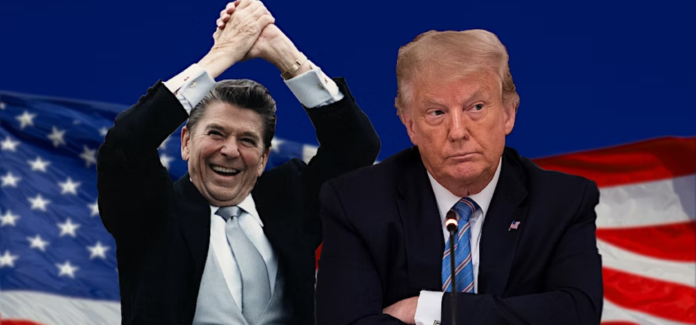When we speak of Trumpism, we refer to the political ideology, style, and movement tied to Donald Trump and his supporters.
But it is far more than just a set of policies. Scholars describe it as a blend of right-wing populism, nationalism, anti-establishment rhetoric, and, in some interpretations, illiberal or authoritarian leanings.
It champions “America First” over international commitments, focuses on national identity, and celebrates industrial strength over post-industrial globalism.
In short: It is simultaneously a set of policy tendencies, a rhetorical style, and a movement anchored by personality and identity.
Origins and Historical Context
To understand Trumpism, it helps to trace its roots and how it emerged.
- The term “It began to circulate widely around 2015 – 2016, when Donald Trump announced his presidential run.
- Some scholars locate its roots in earlier movements: the “America First” ideology of the early 20th century, paleoconservatism in the U.S., and global waves of populism.
- Trump brought populism from the margins into the centre of U.S. politics — tapping into economic anxieties, immigration fears, and disaffection with elites.
This context reveals why It resonated: a period of stagnant manufacturing jobs, rising inequality, growing globalisation backlash, and a feeling of being “left behind” created fertile ground for the rise of a movement promising disruption and national re-assertion
Core Features of Trumpism
Here are the principal dimensions that define Trumpism — often overlapping and inter-connected.
Nationalism & “America First”
A key pillar of It is the notion of national prioritisation: putting one’s own country ahead of global commitments, emphasising sovereignty, borders, and national identity.
This includes:
- Emphasising immigration control, border security, and the “othering” of certain groups.
- Rejecting or renegotiating international agreements seen as disadvantaging the country.
- Asserting a direct bond between the leader and “the people,” sometimes bypassing traditional institutions.
Populism and Anti-Elitism
Another core dimension: It appeals to a “forgotten” or “neglected” majority and frames the established political, media, or economic elites as enemies. The rhetoric frequently pits “the people” against “the elite.”
This anti-elitist flavour shows itself in:
- Critiques of globalisation and outsourcing.
- Emphasis on the working class, manufacturing, and “real Americans.”
- Use of simple, direct, combative language that differs from technocratic politics.
Economic Focus and Industrialism
Beyond rhetoric, It has a material economic dimension: emphasising industrial jobs, manufacturing, trade protectionism, and challenging global supply chains.
Key points:
- Support for tariffs and renegotiated trade deals.
- Use of policy to protect domestic jobs and industries.
- Linking economic decline to larger structural changes not addressed by previous administrations.
Communication Style & Media Strategy
It is not just what is said — but how it is said, and how media is leveraged. The persona of Donald Trump, his direct communication (via social media, rallies), and provocative style are integral.
Characteristics include:
- Use of personal attacks and branding (“Crooked Hillary”, “Sleepy Joe”).
- Blurring of fact and rhetoric, heavy use of emotion.
- Emphasis on spectacle, personal charisma, and loyalty.
Some analysts even argue that the “cult of personality” dimension is central to Trumpism.
Impact on U.S. Politics and the Republican Party
How has Trumpism changed the political landscape?
- Within the Republican Party, It shifted the centre of gravity: loyalty to Trump and his style became a central litmus test, often eclipsing traditional conservative ideology.
- It altered electoral coalitions by appealing to segments of the white working class, while alienating some suburban and college-educated voters.
- Institutionally, It emphasises executive power, skepticism toward media and courts, and a direct bond with “the people,” raising questions about checks and balances.
- Policy outcomes reflected this worldview: trade wars, deregulation, immigration enforcement, and a realignment of foreign policy priorities.
In short, It reshaped both ideology and power structures in American politics.
Global Resonance and Comparisons
Although born in the U.S. context, the phenomenon of It has echoes in other parts of the world.
It shares features with right-wing populist movements elsewhere — nationalism, anti-immigration sentiment, and scepticism of globalisation.
It has been compared to populist leaders in Europe and Latin America, where charismatic figures have similarly blended nationalism, populism, and anti-elitist rhetoric.
While the specifics of It are rooted in U.S. history, the patterns it embodies — populism, nationalism, and personality-based leadership — are increasingly global.
Critiques and Concerns
Democratic Norms and Rule of Law
Critics argue that tendencies within Trumpism — such as emphasis on personal loyalty, executive dominance, and distrust of institutions — pose serious risks to democratic norms and the rule of law.
Identity, Belonging and Exclusion
Analysts point out that identity politics, particularly national and racial identity, are central to Trumpism. Many view it as a reaction to perceived cultural displacement, often manifesting as exclusionary or divisive politics.
Ideological Coherence and Policy Stability
Some observers question whether Trumpism constitutes a stable ideology. Its policy positions often shift with context, prioritising personal and emotional resonance over long-term ideological consistency.
Global Implications
The rise of Trumpism-style politics worldwide raises concerns about democratic backsliding, authoritarian tendencies, and increasing polarisation in global politics.
Future of Trumpism
What lies ahead for Trumpism?
- Durability: Many analysts believe Trumpism will outlast Donald Trump himself, because it reflects deeper economic and cultural divides.
- Institution-Building: Elements of Trumpism may persist through think-tanks, political groups, and ongoing policy initiatives.
- Adaptation: Trumpism may evolve with time, adapting to new contexts, technologies, and voter priorities.
- Backlash and Evolution: Resistance to Trumpism — from both within and outside the Republican Party — will influence how the movement changes.
Trumpism, therefore, remains a living, evolving force that continues to shape political debate in the U.S. and beyond.
Conclusion
In this deep dive into Trumpism, we’ve explored what the term means, its origins, defining features, impact on politics, global echoes, critiques, and possible future.
Trumpism is more than a buzzword — it’s a political movement with profound consequences. Whether viewed positively or negatively, its influence has reshaped the terrain of political discourse, institutional norms, and voter alignment in the 21st century.
As the political landscape continues to evolve, understanding Trumpism offers valuable insight into how personality, policy, identity, and power interact in modern democracies.
FAQ
Q1: What is the difference between Trumpism and traditional conservatism?
Traditional conservatism emphasises limited government and free markets. Trumpism, however, adds strong nationalism, populist anti-elite rhetoric, and economic protectionism to the mix.
Q2: Is Trumpism only about Donald Trump?
While it originated with Donald Trump, many scholars argue Trumpism is broader — representing a political style and set of beliefs that could outlive his direct leadership.
Q3: Can Trumpism be found outside the U.S.?
Yes. Similar populist and nationalist movements have appeared globally, echoing Trumpism’s themes of identity, sovereignty, and anti-globalisation.
Q4: What are the biggest risks of Trumpism?
The main risks include erosion of democratic norms, deepened polarisation, and rising distrust in institutions like the judiciary and media.
Q5: Will Trumpism disappear soon?
Unlikely. Its roots in social, cultural, and economic tensions suggest that while it may evolve, it won’t disappear quickly.


